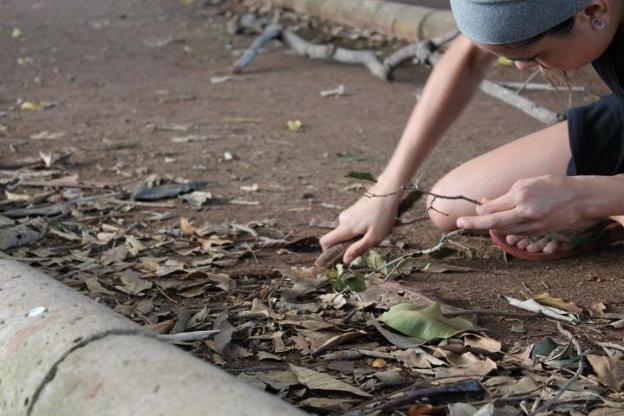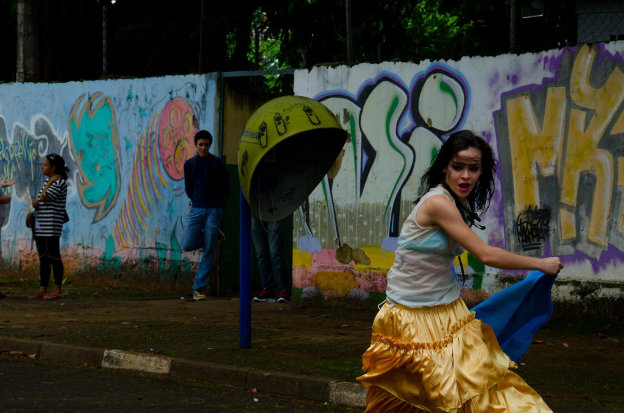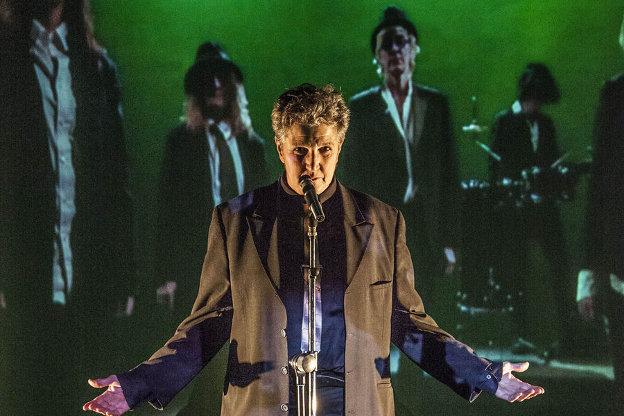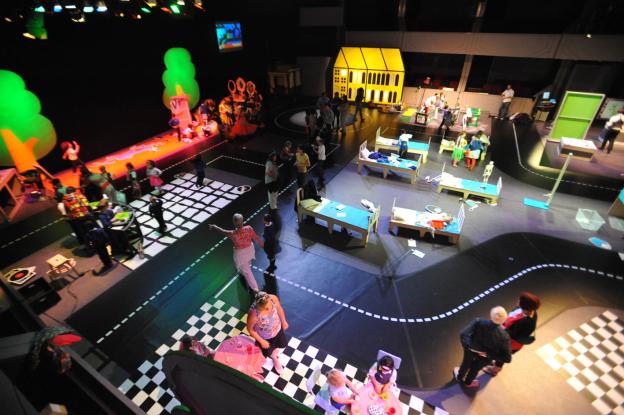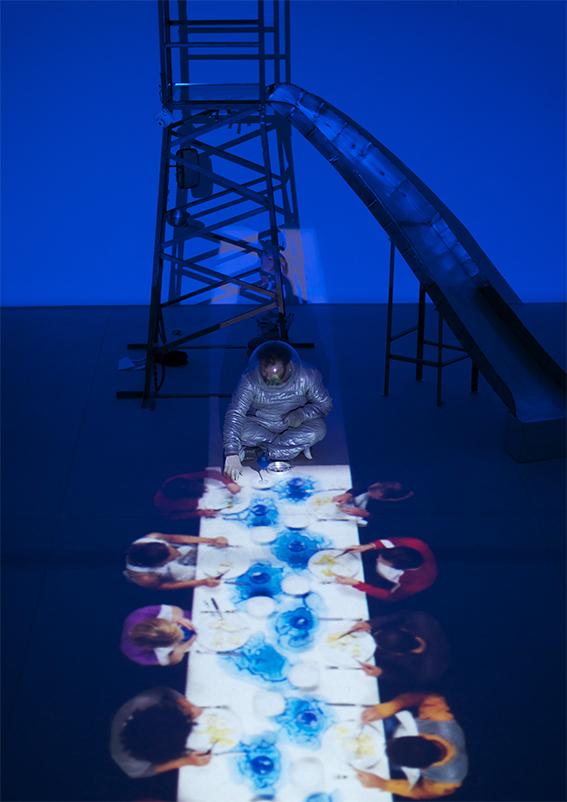As I write (April 2013), the new dreamthinkspeak show In the Beginning was the End has just finished a run at Somerset House; Look Left Look Right (who won a Total Theatre Award for their show You Once Said Yes, set on the streets and public spaces of Edinburgh) open their latest one-on-one show Above and Beyond, commissioned for the Corinthia Hotel; and booking is opening for the new Punchdrunk show, The Drowned Man: A Hollywood Fable, which is based on Büchner’s Woyzeck.
Site-responsive theatre is everywhere these days – in some ways one of the newer strands of contemporary theatre, in other ways one of the oldest forms, perhaps as old as theatre itself.
In recent decades, the form has moved from being mostly associated with Artaudian theatre-of-the-senses – highly physical, visual and visceral fantasias set in warehouses or abandoned industrial sites, as practised in their very different ways by Catalan trailblazers La Fura dels Baus and the legendary Dutch company Dogtroep – to embrace all manner of theatrical forms, from the Mis-Guides and mythogeographic drifts of Wrights & Sites through to the issue-based drama of acclaimed Scottish production Roadkill (which took its audience on a journey in the company of a trafficked girl held captive in a flat on a Glasgow housing estate), via the many and various off-stage theatrical experiments of the Shunt collective.
Having recently led a five-day course at LUME Teatro (Brazil) called Bem Aqui, Bem Agora – Right Here, Right Now / Site-Responsive Theatre and Performance (27 February to 3 March 2013), I felt that right here and now would be a good opportunity to reprise my long-standing relationship to this area of work; to muse on some of the common terminology used; and to reflect on the way that the course gave me (as well as the students, hopefully) good insights into the real joys and challenges of this area of performance practice.
You’ll note that I say ‘site-responsive’, which has been the preferred term in recent years, rather than ‘site-specific’. There is a lot more to be said about that, but not quite yet! First to say is that site-responsive theatre and outdoor performance are dear to my heart, both as an artist/teacher and as a commentator on other’s work.
Ragroof Theatre’s Bridges. Photo by Rosie Powell
As an artist, working with Ragroof Theatre, Grist to the Mill, Dorothy’s Shoes, and other companies I more often than not create work that is sited outside regular theatre buildings. Some of it could be called ‘site-responsive theatre’ and some could be called ‘street theatre’ and some could be called ‘performance in public spaces’. Some is harder to categorise… It’s hard to say precisely when and how my decision to work outside of regular theatre spaces got made, it just seemed to happen – but reflecting back on how things evolved, it is surely a lot to do with a desire to make work for people who don’t often go to the theatre; to really enjoy the kind of audience relationships that occur in public spaces; and to create truly 3D theatre and performance work that isn’t just a framed image viewed from the fixed point of a theatre seat.
This work is extremely varied, although what it always has at its heart is an interest in exploring the relationship with audience and site. With Ragroof Theatre, I have, over the past decade, helped to create large-scale projects set in car parks and dilapidated buildings (what we could see as the now-traditional arena for ‘site-responsive’ work). One of these was Bridges, a piece about migration and transience and a search for home; another was a ‘site-generic’ (more on terminology later – yes it’s coming soon!) show made for dancehalls and bandstands; and yet another was a show about boxing (set in boxing clubs, but also performed with its own touring boxing ring). Most recently, our Youth Club was set in a working building – a three-storied youth centre with a massive skateboard park on the top floor, a dance studio, a gymnasium, and various other arts and sports rooms. We found that trying to work in an occupied building is very different to working in an empty warehouse or car park – both have their challenges and rewards but I’d say that the problems of clearing rubble and rotting rubbish from an abandoned warehouse are nothing compared to trying to plot routes and devise scenes round a busy youth centre you have very limited access to at only some times of the day or night!
With Grist to the Mill, I recently (2012) co-created a show commissioned by Dip Your Toe for Brighton Fringe called Kissing the Gunner’s Daughter set inside a facsimile Victorian ‘bathing machine’ – a kind of beach hut on wheels. Using a soundscape of spoken word and composed music, and a visual landscape of puppetry, animation, and installation, we created an installation/performance peepshow using nautical folk tales and fairytales as our starting point. So, a work about the sea set in hut on a beach, with the sounds of both live and pre-recorded seagulls and waves and boats causing a very lovely aural confusion!
Dorothy’s Shoes is the vehicle for my own personal performance/art projects with invited collaborators, which includes work indoors and out. Behind the Moon, Beyond the Rain was a commission for Anglo-Brazilian festival BR-116 in collaboration with LIFT, made for the buses, trains and public spaces of East London; and Flying Down to Rio was an interactive performance and installation work set in a dancehall, co-commissioned by Sacred Festival at Chelsea Theatre, London, and Entre_Lugares at Sergio Porto in Rio. The former operated in public space, mostly on public transport, so an enormous number of variables were had a bearing on the performance. Who, for example, could have predicted the moment in which a fairytale princess on rollerblades got chased along the glass bridge of West Ham tube station by a bunch of coppers? The latter was a far more controlled and staged event, in which the two commissioning theatres had the nooks and crannies of their space transformed into shrines and film booths, or became the site for a carnival in a cupboard… Yet although an indoor site is far more ‘controllable’, the enormous variable in a show in which the audience can roam free under the twinkling fairy lights (rather than be strapped into seats in the darkness) is the audience – and careful thought has to go into the management of that audience in the space.
So, that’s a few examples from my own experience of how site can become a major character in the show. Now, onto that niggling matter of definitions within the umbrella term ‘site-responsive’, with a few examples from recent work seen…
Let me start by letting loose a bee from my bonnet: the term ‘site-specific’ is used more and more often these days, yet very little of what is presented is truly site-specific. The clue is in the name: a site-specific work is specific to that site and no other. It cannot tour, it was created right here, and it belongs right here and now. No other time or place is possible.
A good example was seen in Sao Paulo, Brazil, where I spent a few days in January before moving onto LUME’s headquarters in Campinas. Teatro de Vertigem’s Bom Retiro 958 Metros is a truly site-specific theatre show. It is a response to a kilometre-long stretch in Sao Paulo, an area called Bom Retiro, which has traditionally been the core of the dressmaking and tailoring industries. Teatro de Vertigem followed an extensive process of interviewing residents, street-dwellers and immigrants to the area (and like many inner city areas worldwide, this area has seen waves of immigrants over the years – traditionally a Jewish area, the main ‘newly immigrant’ group here now are the Koreans). The reminiscence work has gone hand-in-hand with a process of historical research, and a (psycho) geographic and choreographic investigation of the chosen site (which includes narrow streets, a shopping mall, a busy crossroads, and an abandoned clothing warehouse), and these sites, together with the specific stories of inhabitants past and present (of seamstresses and consumers; street-dwellers and landlords; warehouse skivvies and fashion mannequins) are what makes the piece what it is.
Teatro de Vertigem’s Bom Retiro, Sao Paulo, Brazil
So, there is some work that is truly ‘specific’ to its site, but a great deal of performance work presented as ‘site-specific’ is in fact ‘site-generic’ (a term coined by UK company Wrights & Sites, who create work of very many different sorts, usually outdoors, often site-specific). By ‘site-generic’ we mean that the work is made for a particular genre or type of site, but it doesn’t necessarily have to live in that site – it could tour to another similar site. Examples of sites used by artists are many and various, but include: shops, hotels, bars, ballrooms, parks, churches, graveyards, bus stations, trains, kitchens, bathrooms, playgrounds, supermarkets… Of course some work in these sorts of sites is ‘specific’ to that site. Or perhaps the core of the show is ‘generic’ but some changes are made each time it is presented in a new site to make it ‘specific’ to that site. Examples of artists who work in this way includeGrid Iron, who have made shows in department stores, airports, bars, children’s playgrounds and museums amongst other sites. Stalwarts of the Edinburgh Fringe, their new show, Leaving Planet Earth, will instead be part of Edinburgh International Festival 2013.
Then there’s a whole body of work we could label ‘community responsive’ – site-sensitive work that is as interested in the people that use a particular site as it is in the site itself: the place, its use, and the people who use it are all interlinked, and it is this that is of interest to the theatre-maker/artist. It may (as in the case of Bom Retiro, cited above), be a fully site-specific work about one particular community in one geographic location, and thus non-tourable – or it could be an ongoing project recreated in numerous different communities with shared factors or interests. Often in community responsive / site-sensitive work, the line between ‘professional’ and ‘community’ art is deliberately blurred: the work is led by professional artists, but the engagement of the community that is being worked with is crucial, and their active involvement key to the success of the project. An artist who immediately springs to mind to cite here is Keith Khan, an example of someone who, both with Moti Roti and as a solo artist, has taken the notion of art within a community to its highest levels.
Linked to the above, historical and research-based work extends the interest from the current users of the site to its historic users. A very common example of this strand of work will be focused on a well-known historic event, series of events, or crime that took place in a certain site. Often the historical/research approach will combine with an interplay with other, imaginative elements in the creation of performance or installation – see, for example, Peter Reder’s work, including his latest piece The Contents of a House, presented atBrighton Festival 2013. (Brighton Festival have shown a longstanding commitment to supporting and commissioning site-responsive work, with past successes including pieces by Dreamthinkspeak, Frantic Assembly, and Fevered Sleep.)
Moving into more nebulous areas of performance/art: the ‘psychogeography’ movement, which has close ideological links to the French Situationist movement, sets out to reclaim the streets with artistic intention, using ‘drifting’ (walking with an open heart and mind), and conscious walking / meditative walks – mentally remapping and redesigning the environment. In the UK artists such as writer Iain Sinclair, photographer Mark Powers, artist Janet Cardiff, and theatre-makers Wrights & Sites (who describe themselves as ‘a group of artist-researchers with a special relationship to site, city/landscape and walking’), have been at the heart of this movement.
Mythogeography, a term coined by Phil Smith of Wrights & Sites, takes the psychogeographic approach deeper, proposing a multi-layered investigation of the streets, shopping malls, rivers and fields around us, taking in archaeology, anthropology, history, geography, sociology, and of course mythology. Many of the exercises I used in the Bem Aqui, Bem Agora workshop – themed daily walks focusing on, say, touch or smell, or what’s above in the skies, or what’s below at street level; creating portraits of a street; using maps to inspire memories of places never visited – were inspired by or adapted from the works of Phil Smith and Wrights & Sites, and in particular by their marvellous Mis-Guides (to Exeter and Everywhere).
Abre Alas outdoor performance by LUME Teatro, February 2013
Another area of work that I’ve become increasingly interested in over the years is the creation of ritual performance and Rites of Passage ceremonies. Welfare State International were for many decades pioneers of site-responsive performance. Over the years, the company moved from creating large-scale outdoor works to focusing on smaller-scale work, and developing models for alternative Rites of Passage to mark key moments in life such as marriage or the birth of a child. Such work blurs the boundaries between ‘real life’ and ‘art’. Welfare State co-founders John Fox and Sue Gill have since formed Dead Good Guides, ‘an artist-led company, seeking a role for art that weaves it more fully into the fabric of our lives’. Dead Good Guides focuses on rites of passage enactment and training, and on environmental art (by which I mean art that not only has the natural environment and the human relation to it as its subject, but which also places that art within the environment). One of the key elements of the Dead Good Guides rites of passage work is the creation of a new ‘sacred art’ that exists outside of conventional religious practice.
Within the Right Here, Right Now workshop, I included exercises on shrine-building and the creation of mini ‘instant ceremonies’ for a new (non) religion that were inspired by work that I had done in the past with Sue Gill, John Fox and Gilly Adams of Dead Good Guides. It was a delight to meet the various gods and goddesses of the night garden that my dear students unearthed in their work… During our afternoon sessions we had outings to the lovely Praca de Coco, whose trees and plants and pathways presented all sorts of opportunities to explore the possibilities of installation and durational performance work. A nod here in the direction of environmental art companyRed Earth, whose work sits between visual arts/sculpture, durational installation and performance.
From the rural to the urban: it would be a mistake to forget that the city is an environment too. I’ll just mention in passing the possibilities of parkour, street dance and circus/aerial dance – all of which interact with the urban environment – and contain myself to reflecting on how street theatre and site-responsive theatre are placed in relation to each other. Street theatre – unless it is just a regular play set outdoors on a static stage, which is not true street theatre, just theatre placed outdoors – is inevitably site-sensitive, as it is not possible to perform in a public space without being responsive in some way to the environment in which the performer is working. But street theatre is usually less concerned with site per se as it is with audience, and that relationship to audience is the key defining characteristic of ‘street theatre’ – it takes place in a public space (street, beach, bar, hospital, shopping mall), it is unticketed and at no cost to the audience, and the audience is free to walk away if they wish.
Abre Alas rehearsal, LUME Teatro February 2013
The performer/audience relationship is of course always crucial in theatre, but in street theatre the artist has no stage to define their performance area, no pre-existing division between performance space and audience space, and no ‘fourth wall’ to hide behind. The crossover between site-responsive theatre and street theatre occurs when the performance takes place in public spaces. Some forms of street theatre / performance are of course more fully site-responsive than others, and some street theatre work is site-specific – but this isn’t a defining characteristic. In our workshop, we crossed over into more familiar street theatre territory when we developed a city maps exercise into an ensemble piece set in a petrol station and neighbouring streets.
This last example was one of many versions of ‘transposition’ that we used on the course. By which I mean the process of taking material inspired by a response to one site and siting it elsewhere. Of course, in the making of theatre, we do this all the time – take pre-existing texts or memories or imaginative ideas and transpose them to the theatre or rehearsal room. But the key difference here is the choice to transpose these elements into a new ‘non-theatre’ site in order to enjoy the ambivalence of the two placed together. Another example from the Bem Aqui, Bem Agora workshop: we can take memories of our home, images of our home, songs from our homeland and we can create a new ‘home’ elsewhere (in this case, in the LUME house or garden) and explore how these two ‘homes’ fit together.
One last nod in the direction of Wrights & Sites and an idea mooted in the Mis-Guides: ‘imaginary site’ work is the natural extension of the notion of transposition. In this case, we are allowing our imaginations to run wild in our response to a site: perhaps we see angels in the sky, or spirits in the trees. Or perhaps we imagine ourselves to be a stray dog seeking out the best porch to shelter under – as we did in one of the most moving exercises on the workshop, which we dubbed ‘Simi’s Dog’ in honour of the dog who took up residence outside LUME actor Carlos Simioni’s house. Framed within a silent city walk after dark, the street in which LUME are based was brought to life by a series of beautifully performed miniature performance pieces in which drunks, strays, cats, birds, wandering spirits and homeless waifs emerged from the shadows to tell their stories in words, pictures, and physical actions. Each person used the site they had chosen artfully. Pavement stones and steps, doorways and gates, parked cars and moving people, trees and bushes, stacks of wood – each was integrated beautifully with the chosen performance mode. One of the highlights of a very fruitful week of explorations of ways we can respond to a given site.
Bem Aqui, Bem Agora photos from showings of installation work in progress in the Praca de Coco, Barao Geraldo, March 2013.
Bem Aqui, Bem Agora – Right Here, Right Now – Site-Responsive Theatre and Performance, led by Dorothy Max Prior, took place 27 February to 3 March 2013 as part of LUME Teatro’s February workshop season and Terra LUME programme, at the company’s base in Barao Geraldo, Campinas SP, Brazil.
LUME Teatro are supported by and affiliated with UNICAMP (University of Campinas).

